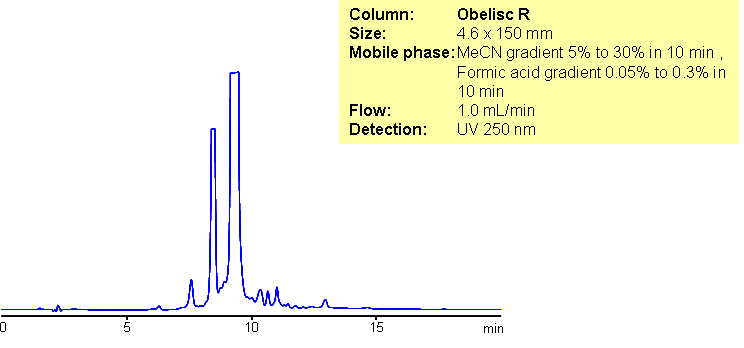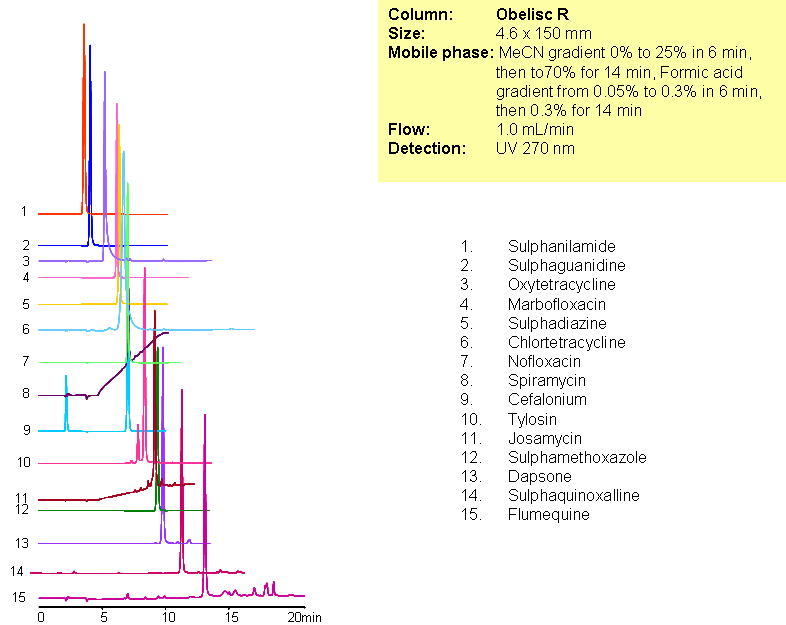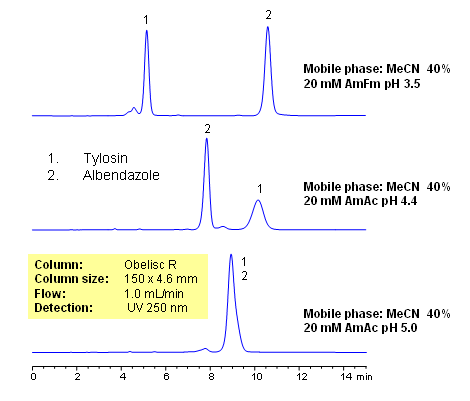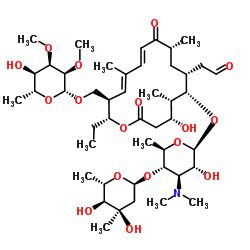| CAS Number | 1401-69-0 |
|---|---|
| Molecular Formula | C46H77NO17 |
| Molecular Weight | 916.112 |
| InChI Key | WBPYTXDJUQJLPQ-SZRMRBKTSA-N |
| LogP | 1.63 |
| Synonyms |
|
Applications:
Analysis of Antibiotic Tylosin and Related Impurities in Mixed-Mode Chromatography
May 12, 2015

Tylosin is a macrolide antibiotic with a broad spectrum of activity against gram-negative and gram-positive organisms. It is highly polar and basic molecule with limited retention in reversed-phase chromatography. Tylosin and related impurities were analysed on Obelisc R trimodal column. Method is compatible with LC/MS and prep chromatography and can be used for HPLC analysis of tylosin in various biofluids.
| Column | Obelisc R, 2.1×150 mm, 5 µm, 100A |
| Mobile Phase | Gradient MeCN – 5-30%, 10 min, 5 min hold |
| Buffer | Gradient Formic Acid – 0.05%-0.3%, 10 min, 5 min hold |
| Flow Rate | 1.0 ml/min |
| Detection | UV, 250 nm |
| Class of Compounds |
Insecticide, Herbicide, Fungicide, Hydrophobic, Ionizable |
| Analyzing Compounds | Tylosin |
Application Column
Obelisc R
SIELC has developed the Obelisc™ columns, which are mixed-mode and utilize Liquid Separation Cell technology (LiSC™). These cost-effective columns are the first of their kind to be commercially available and can replace multiple HPLC columns, including reversed-phase (RP), AQ-type reversed-phase, polar-embedded group RP columns, normal-phase, cation-exchange, anion-exchange, ion-exclusion, and HILIC (Hydrophilic Interaction Liquid Chromatography) columns. By controlling just three orthogonal method parameters - buffer concentration, buffer pH, and organic modifier concentration - users can adjust the column properties with pinpoint precision to separate complex mixtures.
Select optionsUV Detection

Separation of Antibiotics in Mixed-mode chromatography
May 11, 2015

A complex mixture of sulphonamide, macrolide, tetracycline and fluoroquinolone antibiotics were separated in one run using mixed-mode chromatography with LC/MS -compatible conditions. All compounds are separated based on reversed-phase and/or ion-exchange mechanism. Method can be used for analysis of various classes of antibiotics and related impurities in different sample matrices (blood, urine, soil, waste water).
| Column | Obelisc R, 2.1×150 mm, 5 µm, 100A |
| Mobile Phase | Gradient MeCN – 0-25%, 6 min, 25-70% 14 min |
| Buffer | Gradient Formic Acid – 0.05%-0.3%, 10 min, 14 min hold |
| Flow Rate | 1.0 ml/min |
| Detection | UV, 270 nm |
| Class of Compounds |
Antibiotic, Drug, Hydrophobic, Ionizable |
| Analyzing Compounds | Sulphanilamide, Sulphaguanidine, Oxytetracycline, Marbofloxacin, Sulphadiazine, Chlortetracycline, Nofloxacin, Spiramycin, Cefalonium, Tylosin, Josamycin, Sulphamethoxazole, Dapsone, Sulphaquinoxalline, Flumequine |
Application Column
Obelisc R
SIELC has developed the Obelisc™ columns, which are mixed-mode and utilize Liquid Separation Cell technology (LiSC™). These cost-effective columns are the first of their kind to be commercially available and can replace multiple HPLC columns, including reversed-phase (RP), AQ-type reversed-phase, polar-embedded group RP columns, normal-phase, cation-exchange, anion-exchange, ion-exclusion, and HILIC (Hydrophilic Interaction Liquid Chromatography) columns. By controlling just three orthogonal method parameters - buffer concentration, buffer pH, and organic modifier concentration - users can adjust the column properties with pinpoint precision to separate complex mixtures.
Select optionsChlortetracycline
Dapsone
Flumequine
Josamycin
Marbofloxacin
Norfloxacin
Oxytetracycline
Spiramycin
Sulfamethoxazole
Sulfonamides
Sulphadiazine
Sulphaguanidine
Sulphanilamide
Sulphaquinoxaline
Tetracycline
Tylosin
UV Detection

HPLC Separation of Tylosin and Albendazole
October 4, 2010

Tylosine is an antibiotic used in veterinary medicine. This sugar-based amino compound is found naturally in fermentation products. Presence of sugar moieties and amino group make it impossible to analyze this compound by reversed-phase HPLC with LC/MS compatible conditions. Mixed-mode chromatography allows to overcome this obstacle, and retain and analyze this and other aminoglycosides on an Obelisc R column. This column is suitable for analysis of aminosugars with several basic groups in the molecule (streptomycine, neomycin, amikasin, arbekasin, dibekasin, framycetin, kanamycin, gentamycin, verdomycin, astromycin, hydromycin, etc.). In case of several amino groups, higher buffer concentration and lower pH (3-3.5) are required in order to facilitate elution from the column. This method does not use ion-pairing reagent, and is designed to replace traditional reversed-phase columns and ion-pairing reagent methods. In this application, Albedazole is used as internal standard to quantify aminoglycoside.
Application Column
Obelisc R
SIELC has developed the Obelisc™ columns, which are mixed-mode and utilize Liquid Separation Cell technology (LiSC™). These cost-effective columns are the first of their kind to be commercially available and can replace multiple HPLC columns, including reversed-phase (RP), AQ-type reversed-phase, polar-embedded group RP columns, normal-phase, cation-exchange, anion-exchange, ion-exclusion, and HILIC (Hydrophilic Interaction Liquid Chromatography) columns. By controlling just three orthogonal method parameters - buffer concentration, buffer pH, and organic modifier concentration - users can adjust the column properties with pinpoint precision to separate complex mixtures.
Select optionsTylosin



